Last Updated on March 12, 2023
Spilling spray paint on the carpet is a huge annoyance and can become even worse if you don’t act fast. Waiting too long to clean up your mess could leave an ugly, permanent reminder of what should have been a momentary accident.
Don’t fret. There is a range of techniques that have proved successful in removing spray paint from carpets, including household staples like dish soap or hydrogen peroxide and light solvents such as paint thinner and turpentine. No matter the stain, there’s sure to be an option that’ll help restore your treasured carpet to its former glory.
Let’s explore the ways to make those pesky spray paint stains disappear from your carpets. We’ll show you some effective methods that always get results.
Different Methods on How to Get Spray Paint Out of Carpet
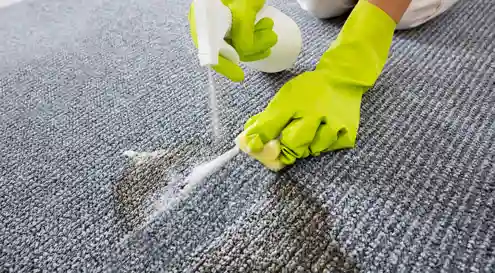
You can use several different methods to remove spray paint from carpets. These include using the following items:
1. Using Paint Thinner
The most popular way to remove spray paint from a carpet is to use paint thinner. Paint thinner is a petroleum-based product that works best when used on fresh spills. To get the most out of your paint thinner, you’ll want to make sure you follow these steps:
Begin by using a clean paper towel or cloth to blot up as much of the spilled paint as possible. Then, saturate a clean cloth with the paint thinner and blot at the stain until it begins to lift from the carpet’s fibers.
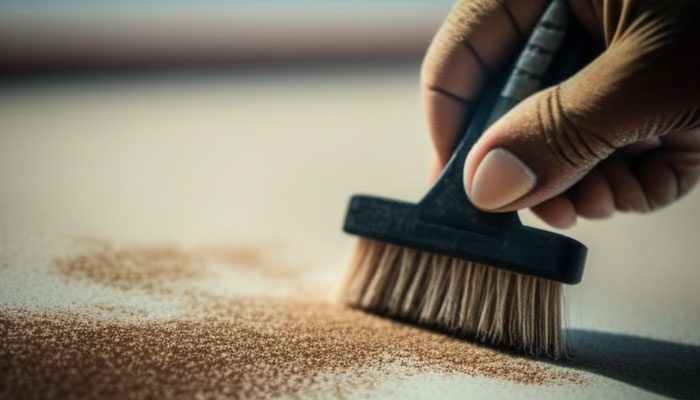
It’s also important not to rub too aggressively, as this will spread the stain further. Once you have blotted up as much of the paint as possible, then you can turn your attention to any remaining stuff that may be left.
Using a soft-bristled brush or toothbrush, gently scrub in circular motions at any remaining residue until it is removed from the fibers. You may need to periodically reapply some of your paint thinner during this process for it to be effective.
When all remains are gone, and your carpet looks new again, ensure you follow up with a few passes from a vacuum cleaner so there isn’t any residual chemical left behind.
2. Using Turpentine
The turpentine will also get the spray paint off carpets. Since it breaks down just about anything oily or waxy, including stubborn spray paint stains on the carpet.
To start, take a clean cloth and saturate it with some turpentine before applying it gently over the stained area in small circles until all visible residue has been lifted away from the fibers of your carpeting.
If needed, use an old toothbrush or soft-bristled brush to help loosen any persistent spots before vacuuming up any leftover particles after they have been broken down by your solvent.
Keep in mind that while this method may work well on water-based paint and fresh spills. Older stains might require extra attention and more than one application of turpentine before they are fully removed from your flooring’s fibers completely.
As always, when handling solvents such as turpentine, it’s important that safety precautions like wearing gloves and ventilating your space adequately are taken, especially if children or pets are present.
3. Using Liquid Dish Soap
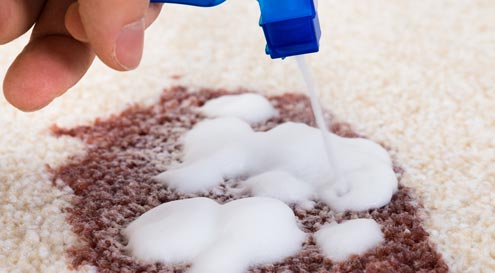
You can also use liquid dish soap. To do this, start by creating a solution of warm water and liquid dish soap. Use enough of each so that there is a good amount of suds in the mixture.
Once you have created your solution, simply apply it directly to the sprayed area on your carpet using a sponge or cloth.
Gently rub the affected area in small circles to help loosen the paint, and then blot away any excess moisture with an absorbent cloth or towel.
You should see some of the paint lifting off your carpet as you work. Continue these steps until all visible signs of the spray paint have been lifted from the surface.
To ensure that all traces of paint are removed, you may need to repeat this process several times to completely remove all the particles and residue left behind by the spray paint.
After each application, allow your carpet time to dry before reapplying more liquid soap solution if necessary.
It is also important to follow up with a thorough vacuuming once the spray paint is gone, as any leftover particles may settle back into your carpet fibers after drying. Over time, it fades or discolors.
4. Using Hydrogen Peroxide
Hydrogen peroxide is another popular option when it comes to removing spray paint from carpets because it can help to break down tough stains more quickly than other methods.
But it should only be used on lighter carpets as it can cause permanent staining if used on darker ones. To use hydrogen peroxide for this purpose, first, ensure that you’re wearing protective gloves. So you don’t irritate your skin or wreck your clothes.
After that, combine equal parts cold water and hydrogen peroxide in a spray bottle and thoroughly saturate the stained area with this solution.
Allow it to sit for 30 minutes before using a paper towel to gently blot away any excess liquid and paint residue from your carpet fiber.
Be careful not to rub too hard or scrub aggressively, as this could cause rips to your carpet’s delicate fibers.
Rinse the affected area with cold water once everything has been removed. Using a dry cloth, wipe the spot until all moisture has evaporated before allowing it to air dry before vacuuming any remaining particles.
When you’re done, ensure you don’t leave a trace of cleaning product behind since they can attract dirt more easily in the future, which could eventually lead to more staining problems.
5. Using Carpet Cleaner

Using a carpet cleaner can be an effective method for removing spray paint from your carpet. When using a cleaner, you should always follow the directions provided on the package of the product and wear proper safety gear, such as gloves and eye protection.
Before application, you should test the carpet cleaning product on a small area of the paint-stained carpet to check for discoloration or fading.
You may want to avoid products with harsh chemicals or bleaching agents in them if you are worried about color damage.
To use a carpet cleaner, start by vacuuming up any loose particles with your vacuum cleaner. Then apply a good amount of the cleaner directly onto the stain and wait for it to work its magic. This could take anywhere from 5 minutes to 10 minutes, depending on how old and dry the stain is.
Once finished, use a damp cloth or paper towel to blot up any excess residue left behind before using warm water and a sponge to rinse away any remaining traces of the cleaner. Let your carpet air dry completely before assessing whether more steps are necessary.
If you find that there is still some residue left behind after drying, you can try using specialized spot cleaners designed for carpets specifically. These cleaners usually contain stronger cleaning solutions that can penetrate deeper into fabrics.
Always make sure you read the directions carefully before use since some formulas may require more time or extra rinsing than others do.
Finally, review your results once everything has been allowed to dry completely. If necessary, repeat these steps until all traces of spray paint have been removed from your carpets.
You Can Also Read: How safe is air freshener for babies?
6. Using Acetone
Acetone is actually an effective method, and it’s easy for anyone with basic tools at home to use. To begin this process, you will need some paper towels and some pure acetone (such as nail polish remover).
Pour a small amount of acetone onto one paper towel and place it onto the area where there is a spray paint stain on your carpets. Ensure you are careful not to saturate too much in one spot.
Carefully dab away at this spot until all the excess colors have been lifted away before moving on to another stained area. Continue repeating this process across each stained spot until all excess color has been removed from your carpets completely.
Once all of these areas have been treated with acetone, use another damp paper towel with warm water only (no additional cleaning solutions).
Gently blot each painted area until all traces of acetone have been fully extracted from within your carpets’ fibers. If necessary, you may need more than one paper towel, depending on how large each affected area is.
Then, allow your carpets ample time for them to dry completely before vacuuming away any residual particles left behind post-cleaning. Typically, at least 24 hours should be sufficient for most types of carpets but always double-check beforehand just in case.
Using pure acetone cautiously, homeowners should experience no problems while removing tough stains such as those caused by spray paint without ruining their beloved carpets.
7. Using Trisodium Phosphate (TSP) and Warm Water

Trisodium phosphate (TSP) is a chemical cleaning product that is often used to get spray paint off carpets. To use TSP, combine one cup of TSP with 1 gallon of warm water in a bucket.
Don’t forget to wear rubber gloves when mixing the solution and working with it, as TSP can be rough on the skin. When using this method, it is important to take great care not to oversaturate the carpet. If too much water is used, it could lead to further damage, such as mold or mildew growth.
Once you have prepared your cleaning solution, use a brush or sponge to apply it directly onto the stained area. Spread the solution over the soiled area and let sit for several minutes before blotting up excess moisture with a paper towel or clean white cloth.
Repeat this process several times if the paint has set into the carpet fibers. Once the paint is all gone, rinse the area with cold water and allow it to air dry before allowing traffic over it again.
When using TSP, take great precautions to ensure its safe use, as it can be caustic and irritate your skin if used improperly.
Don’t leave it on fabrics for too long, and rinse it off afterward with an appropriate rinsing agent. Due to its caustic nature, avoid contact between TSP and any surfaces that might be damaged by its strong alkaline properties, such as grout or stone tiles.
8. Using Hand Sanitizer
Using hand sanitizer is another good way of removing spray paint without harsh chemicals or solvents that could deteriorate fibers or cause discoloration over time.
To utilize this method, start using a vacuum cleaner attachment or scrub brush to loosen any dried paint particles from within your carpet’s fibers. This will make removal much easier later on.
Once you have done this pre-cleaning step, apply a generous amount of hand sanitizer directly on top of the stain and let it sit for several minutes before scrubbing vigorously with a clean white cloth or paper towel. Let it sit until all traces of color are gone.
Like any other cleaning process, where you choose to apply hand sanitizer should also be considered carefully. Because some types may contain dyes that could leave behind unsightly stains when exposed long enough to the carpets.
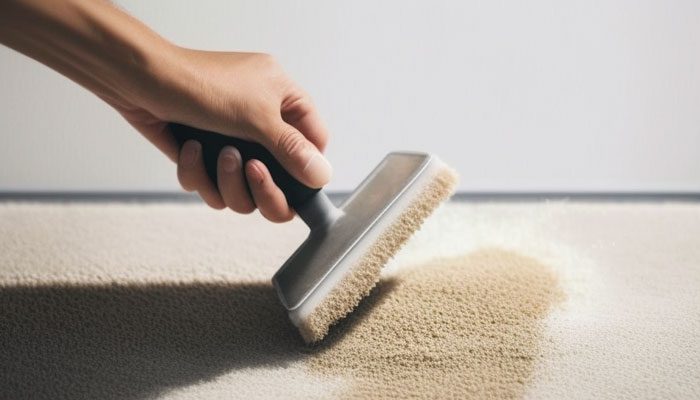
When selecting which type of sanitizer you wish to use for this process, be sure to read labels carefully first so that you can avoid accidentally staining your carpets instead.
After completing your cleaning task using hand sanitizer, finish off by vacuuming up any remaining particles which were loosened during removal before allowing traffic over them once more!
Overall, both trisodium phosphate (TSP) and hand sanitizers are excellent methods for removing spray paint stains from carpets without causing further deterioration than necessary in attempting their removal.
It’s still important to take precautions when using either product to protect your precious floors. The methods above will allow you to remove any spray paint from your carpet, including acrylic paint, chalk paint, latex paint, and oil-based paint.
Does Rubbing Alcohol Remove Spray Paint from Carpet?
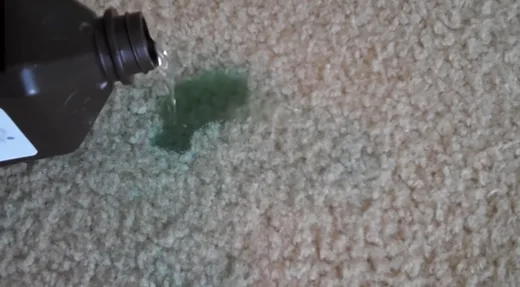
Rubbing alcohol is an effective and safe way to remove dried spray paint from carpets. To use rubbing alcohol, mix equal parts of rubbing alcohol and water in a container, then apply the solution to the affected area with a clean cloth or sponge.
You need to test the solution on an inconspicuous area of the carpet first to ensure that it does not cause any discoloration or other issues.
Once applied, rub gently and continue to reapply the solution until it’s clean. After removing the paint, make sure to rinse off any remaining residue with warm water and allow the area to dry completely before using it again.
Does Vinegar Remove Paint from Carpet?
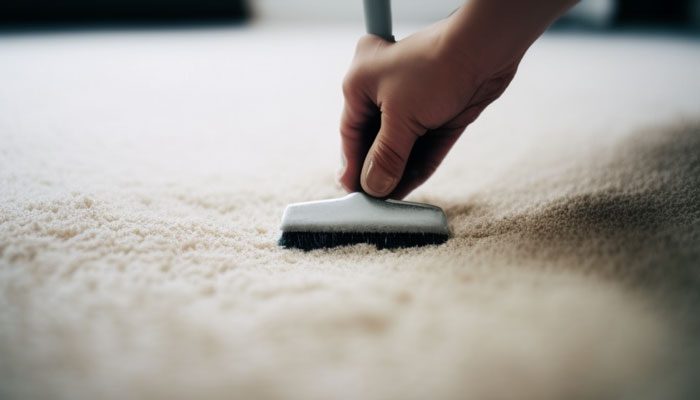
Vinegar works great for removing paint from carpets. It is best for removing wet or semi-dried paint from carpets as it works best when applied shortly after the spill occurs.
Start by mixing one part white vinegar with four parts water, then dip a clean rag into the mixture and dab it onto the stained area of your carpet gently.
Work in a circular motion until all of the paint has been removed, then rinse with warm water and dry thoroughly.
Will Acetone Damage My Carpet?
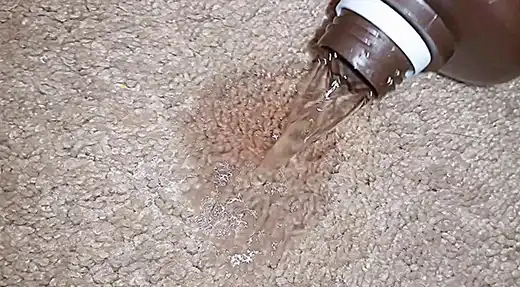
Acetone can cause damage to your carpet if not used properly, so it is essential that you take caution when using it on your carpets. The solvent can cause discoloration and may even dissolve some fibers in your carpet if left on for too long or if too much product is used at once.
When using acetone for cleaning purposes, make sure to apply only a small amount at once, as well as blot it up immediately with an absorbent cloth afterward to avoid damaging your carpeting further.
Keep Your Carpet Looking Good All Time
The key to successfully removing spray paint from your carpets is knowing what products work best for each particular situation.
Whether you use paint thinner, turpentine, white spirits, liquid dish soap, hydrogen peroxide, carpet cleaner, or acetone, all these products serve slightly different purposes for spot-cleaning upholstery and carpets.
For those wanting an extra layer of protection against more difficult stains, however, trisodium phosphate (TSP) mixed with warm water can provide superior results due to its powerful cleaning capabilities.
Finally, for those wanting a quick fix for small spots of spray paint, hand sanitizer can be used in a pinch to break down its pigment molecules quickly.
No matter what product you choose, though, always take the necessary precautions when handling chemicals and test any treatment you plan on using in an inconspicuous area first.
You Can Also Check:

